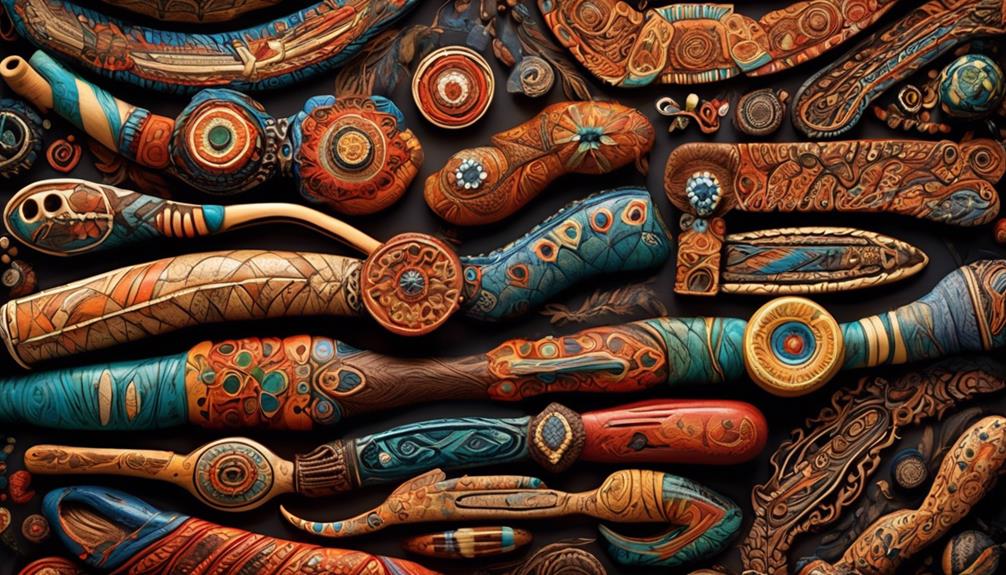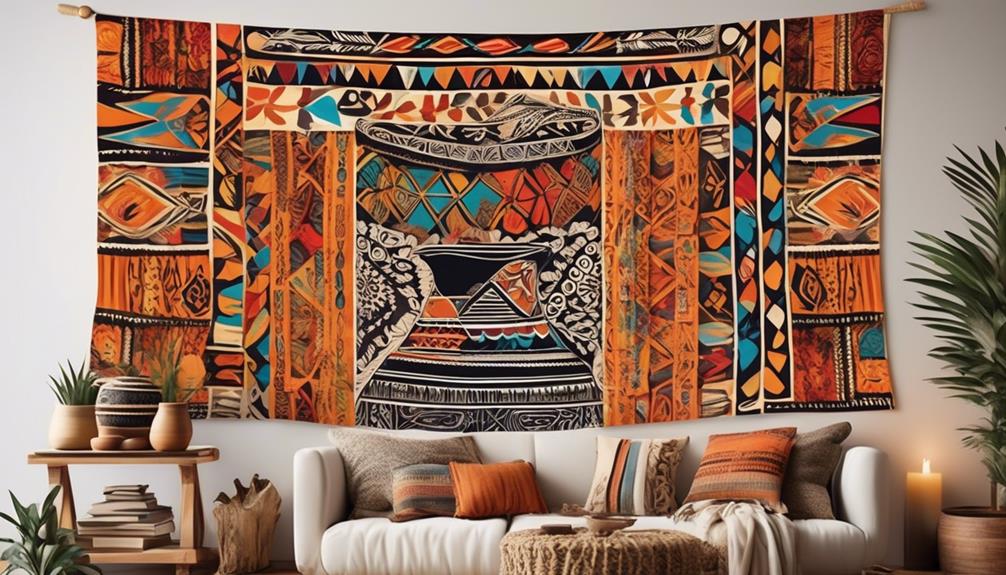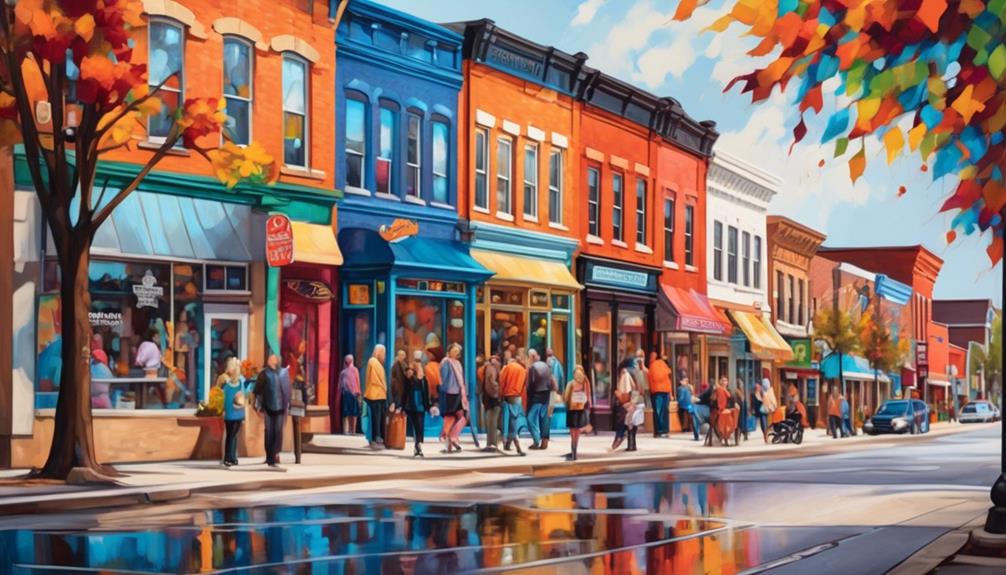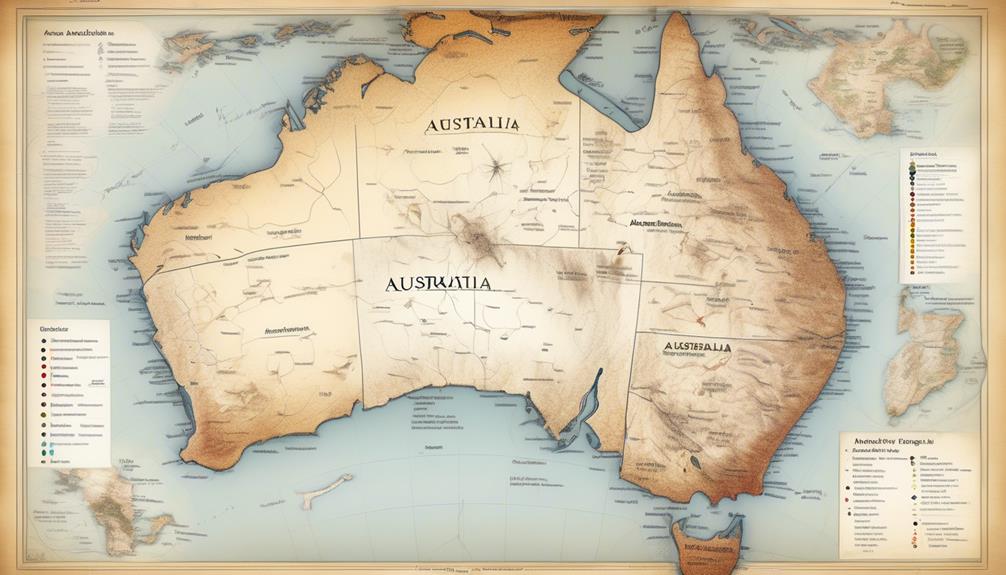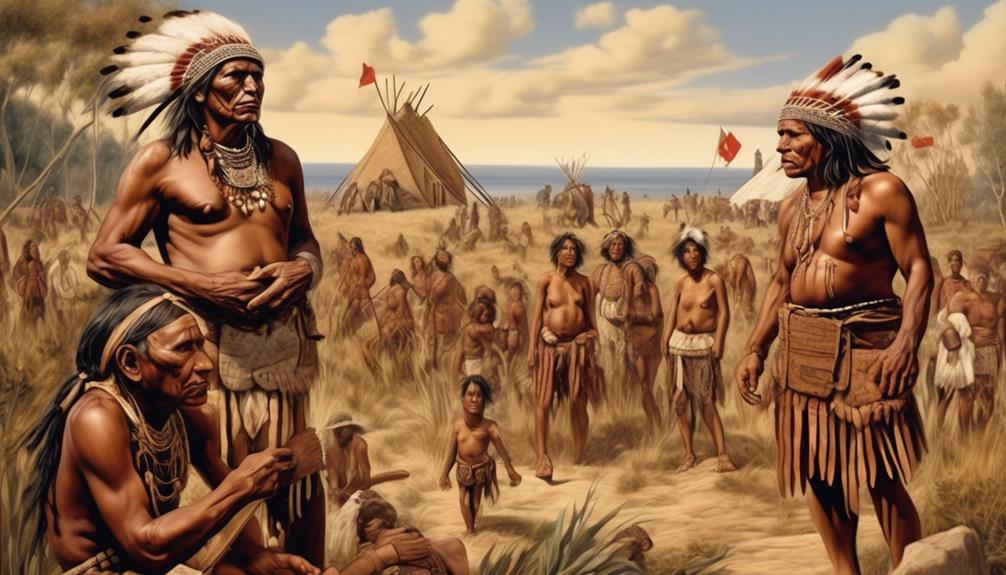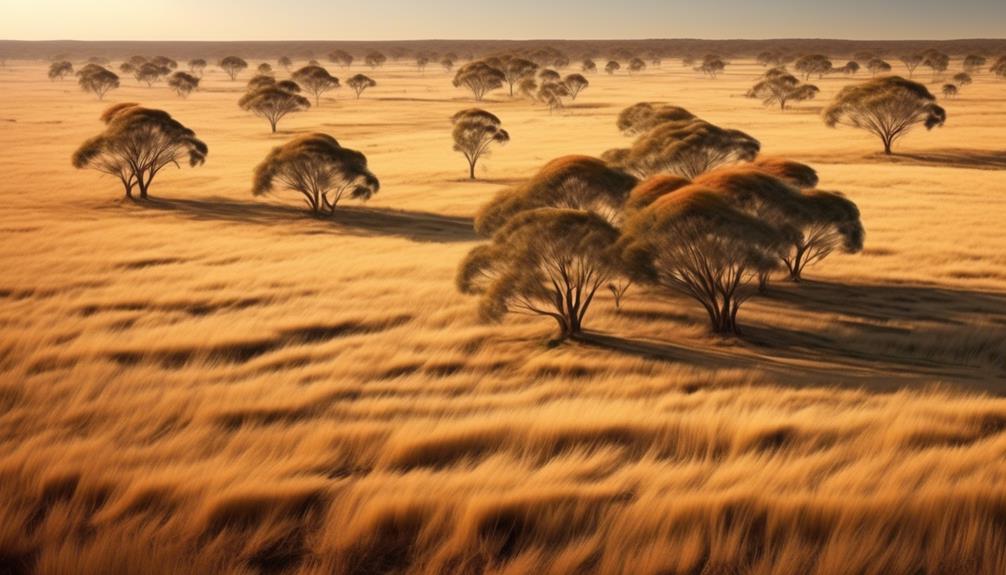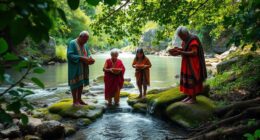Have you ever thought about the stories held within the ancient relics of Australia? From the tools of the Aboriginal people to the artifacts from the colonial era, Australia’s treasures offer a glimpse into the rich and diverse history of this southern land.
As we explore the various forms of indigenous art and the remnants of the colonial past, we uncover a tapestry of cultural heritage that continues to shape the present.
But what secrets do these artifacts hold, and how are they being preserved for future generations?
Join us as we unravel the fascinating world of Australia's artifacts and discover the untold tales that they hold.
Key Takeaways
- Ancient Aboriginal tools and artifacts played a crucial role in the daily lives of Indigenous Australians, reflecting their deep understanding of the environment.
- Rock art traditions, dating back at least 60,000 years, provide insights into the cultural and spiritual beliefs of Indigenous peoples, depicting hunting scenes, daily life, and stories of creation and ancestral spirits.
- Preservation efforts for rock art traditions prioritize ethical sourcing, sustainable practices, and community engagement, fostering shared responsibility and stewardship for cultural heritage.
- Colonial-era relics offer insights into the lives of early settlers, their impact on Australia, and the challenges and triumphs of building settlements in a new environment, emphasizing the importance of preserving artifacts for future generations.
Ancient Aboriginal Tools
Ancient Aboriginal tools played a crucial role in the daily lives of Indigenous Australians, serving a multitude of practical and cultural purposes. The craftsmanship and techniques employed by Aboriginal people in creating these tools reflect their deep understanding of the environment and their innovative problem-solving skills. These ancient tools were meticulously crafted using materials such as wood, stone, and bone, showcasing the resourcefulness and creativity of the Aboriginal people.
The tools themselves varied greatly in function and design. For example, the boomerang, a symbol of Aboriginal culture, wasn't only used for hunting but also held spiritual significance in ceremonies and rituals. Similarly, the intricately carved didgeridoo served both as a musical instrument and a storytelling tool, connecting generations through its melodic tunes and traditional narratives.
The ancient techniques employed in crafting these tools were passed down through generations, reflecting a rich oral tradition and a deep respect for ancestral knowledge. The precision and skill evident in these tools are a testament to the expertise of Aboriginal craftsmen, who honed their techniques over centuries, adapting to the diverse landscapes of Australia.
Understanding the significance of these ancient Aboriginal tools offers a glimpse into the ingenuity and resilience of Indigenous Australians. It's a reminder of the enduring legacy of Aboriginal craftsmanship and the importance of preserving and celebrating these ancient techniques for future generations.
Rock Art Traditions
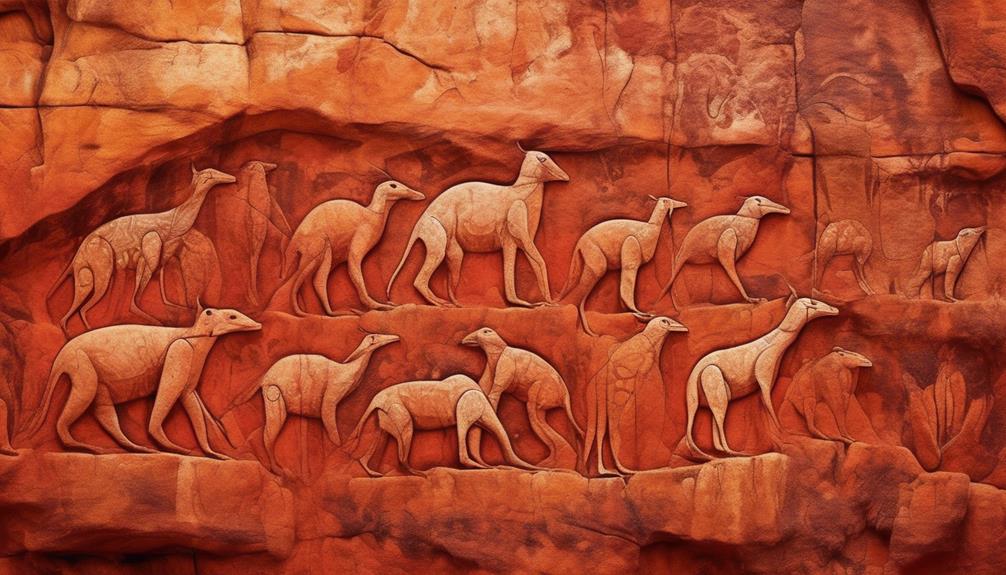
As we explore the rich history of Australia's rock art traditions, we're drawn to the age and origins of these ancient depictions.
The symbolism and meaning behind these artworks provide a window into the cultural and spiritual beliefs of the Indigenous peoples who created them.
Additionally, we'll examine the ongoing efforts to conserve and protect these invaluable pieces of human history.
Age and Origins
Studying the age and origins of Australia's rock art traditions provides valuable insights into the ancient cultural practices and artistic expressions of the indigenous peoples. Archaeological evidence indicates that the rock art traditions in Australia date back at least 60,000 years, making them some of the oldest and most enduring artistic traditions in the world. These artworks often depict spiritual beliefs, hunting scenes, and daily life, offering a window into the rich cultural heritage of the Aboriginal peoples. The diversity of styles and techniques across different regions reflects the complexity and depth of indigenous knowledge and traditions. Understanding the age and origins of these rock art traditions is crucial for appreciating the enduring legacy of Australia's indigenous peoples and their profound connection to the land.
| Age and Origins of Australia's Rock Art Traditions | ||||
|---|---|---|---|---|
| Region | Estimated Age (years) | Styles | Techniques | Cultural Significance |
| Northern Territory | 60,000+ | X-ray, Dynamic | Stippling, Cross- | Spiritual beliefs, |
| Figures | hatching | hunting scenes | ||
| Western Australia | 40,000+ | Gwion, Wandjina | Brushwork, | Daily life, |
| Stenciling | spiritual beliefs | |||
| Queensland | 17,000+ | Quinkan, | Engraving, | Connection to the |
| Painting | land, spiritual | |||
| beliefs | ||||
| South Australia | 30,000+ | Panaramittee, | Abrading, | Landscape, |
| Carving | spiritual beliefs | |||
| New South Wales | 5,000+ | Sydney Sandstone, | Sgraffito, | Cultural practices, |
| Pecking | artistic expressions |
Symbolism and Meaning
The age and origins of Australia's rock art traditions shed light on the cultural symbolism and deep meanings embedded within these ancient artistic expressions.
The symbolism in Australia's rock art reflects the cultural representation of the Indigenous people, their belief systems, and their connection to the land.
The motifs and symbols depicted in the rock art often hold complex meanings, portraying stories of creation, spiritual beliefs, and the natural world.
For example, the presence of certain animals or symbols may signify important cultural totems or ancestral spirits.
These artistic expressions also serve as a visual language, communicating shared cultural narratives and traditions.
Understanding the symbolism and cultural representation in Australia's rock art traditions provides valuable insights into the rich and diverse heritage of the Indigenous peoples and their enduring connection to the landscape.
Conservation Efforts
Our ongoing efforts to preserve and protect Australia's rock art traditions are essential for safeguarding the cultural heritage and historical significance of these ancient artistic expressions.
Ethical sourcing and sustainable practices are at the core of our conservation endeavors, ensuring that any materials used in preservation activities are responsibly and respectfully obtained.
Community engagement plays a vital role in our efforts, as we actively seek to involve and empower local communities in the conservation process.
By integrating traditional knowledge and collaborating with indigenous groups, we honor and respect the cultural significance of the rock art, while also benefiting from the wealth of expertise and insight these communities offer.
Our commitment to ethical practices and community involvement not only ensures the longevity of Australia's rock art traditions but also fosters a sense of shared responsibility and stewardship for this invaluable cultural heritage.
Colonial-era Relics
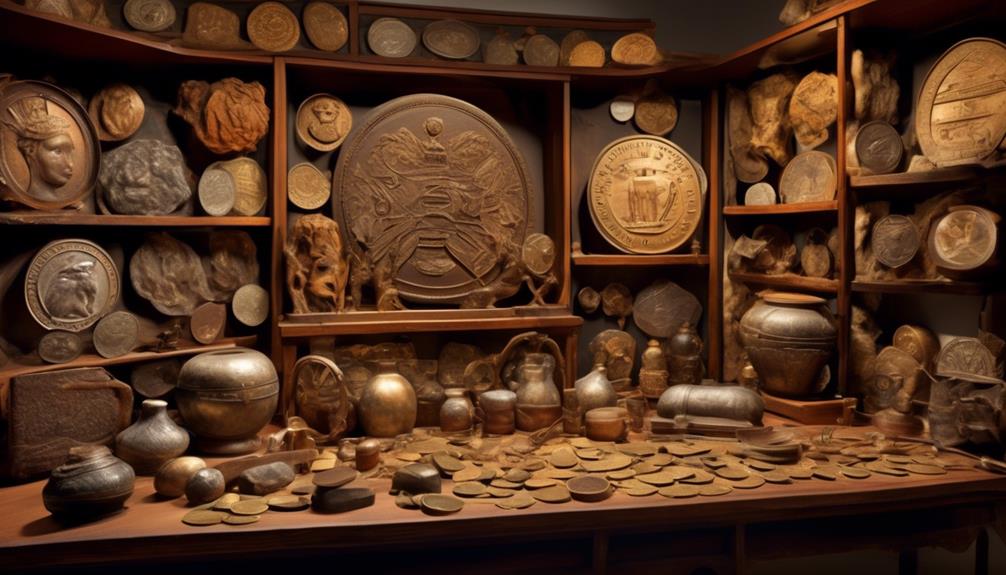
As we examine the colonial-era relics found in Australia, a fascinating and detailed picture of the historical period emerges, shedding light on the lives of early settlers and their impact on the continent. These relics hold immense historical significance, providing invaluable insights into the colonial era and the experiences of those who lived during that time.
- Architectural Remnants: The colonial-era relics in Australia often include architectural remnants such as old buildings, bridges, and infrastructure. These remnants not only showcase the architectural styles of the colonial period but also offer glimpses into the daily lives and activities of the early settlers. Studying these relics helps us understand the challenges and triumphs of building and maintaining settlements in a new and often harsh environment.
- Everyday Objects: Another aspect of colonial-era relics involves the everyday objects used by the early settlers. These can range from household items to tools and personal belongings. Analyzing these artifacts provides a window into the domestic and working lives of the settlers, revealing their customs, technologies, and material cultures. It allows us to comprehend the ways in which these individuals adapted to the Australian landscape and developed their own unique way of life.
- Documentation and Records: Colonial-era relics also encompass written documentation, records, and maps from the time period. These historical documents offer valuable insights into governance, trade, social structures, and interactions between settlers and Indigenous communities. They provide a deeper understanding of the complexities and dynamics of colonial society in Australia, giving voice to a wide array of historical perspectives and experiences.
Studying these colonial-era relics enriches our understanding of Australia's history and the enduring impact of its early settlers.
Indigenous Artworks Today
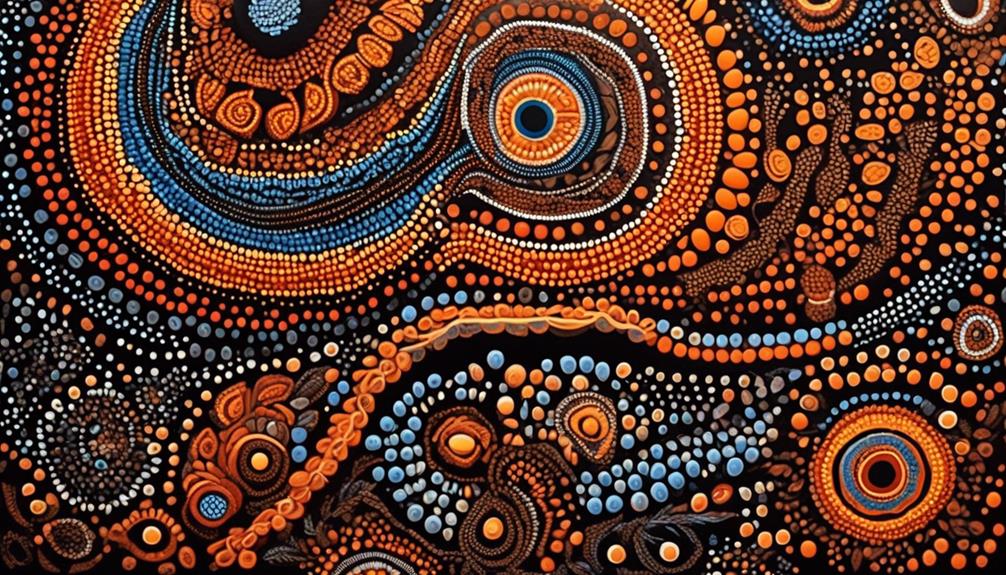
Exploring the enduring connections between colonial-era relics and the contemporary Indigenous artworks today reveals a rich tapestry of cultural expression and artistic resilience in Australia. In the modern Indigenous art market, traditional forms of expression are being reimagined through modern interpretations, reflecting the ongoing cultural vibrancy and adaptability of Indigenous communities.
| Modern Interpretations | Indigenous Art Market |
|---|---|
| Incorporation of contemporary mediums and techniques | Increasing demand for authentic Indigenous artworks |
| Exploration of new themes and narratives | Growth of Indigenous art galleries and online platforms |
| Collaboration with non-Indigenous artists | Rising international recognition and appreciation |
Modern interpretations of Indigenous artworks encompass a wide range of practices, including the incorporation of contemporary mediums and techniques. This approach not only preserves traditional art forms but also allows for the exploration of new themes and narratives that resonate with modern audiences. Furthermore, collaborations between Indigenous and non-Indigenous artists have become increasingly common, fostering cross-cultural dialogue and enriching the artistic landscape.
The Indigenous art market has experienced significant growth, with an increasing demand for authentic Indigenous artworks. This has led to the establishment of Indigenous art galleries and online platforms, providing artists with greater visibility and opportunities for economic empowerment. Moreover, there has been a rise in international recognition and appreciation of Indigenous art, contributing to the preservation and celebration of Indigenous cultural heritage on a global scale.
Boomerangs and Spear Throwers

How did the historical significance of boomerangs and spear throwers contribute to the cultural identity and practices of Indigenous communities in Australia?
Boomerangs and spear throwers hold deep historical and cultural significance for Indigenous communities in Australia. These artifacts not only served practical purposes but also played a vital role in shaping traditional Indigenous practices and cultural identity.
- Boomerang design evolution: The design of boomerangs has evolved over thousands of years, reflecting the deep connection between Indigenous peoples and their environment. Initially used for hunting, boomerangs have also been utilized in cultural ceremonies and storytelling. The unique curved shape and aerodynamic design allowed for varied uses, from hunting to communication. The intricate carvings and paintings on boomerangs also symbolize spiritual beliefs and Dreamtime stories, showcasing the rich cultural heritage of Indigenous communities.
- Indigenous throwing techniques: Indigenous communities developed sophisticated throwing techniques specific to different types of boomerangs. These techniques were passed down through generations, emphasizing the importance of traditional knowledge and skills. The ability to manipulate the flight path of a returning boomerang wasn't only essential for hunting but also served as a form of entertainment and skill demonstration within the community.
- Spear thrower function: Spear throwers, also known as woomeras, were essential tools for traditional hunting methods. These devices enabled hunters to launch spears at greater distances and with increased accuracy, enhancing their effectiveness in securing food for the community. The use of spear throwers required extensive knowledge and expertise, highlighting the importance of hunting skills within Indigenous cultures.
Bark Paintings and Carvings
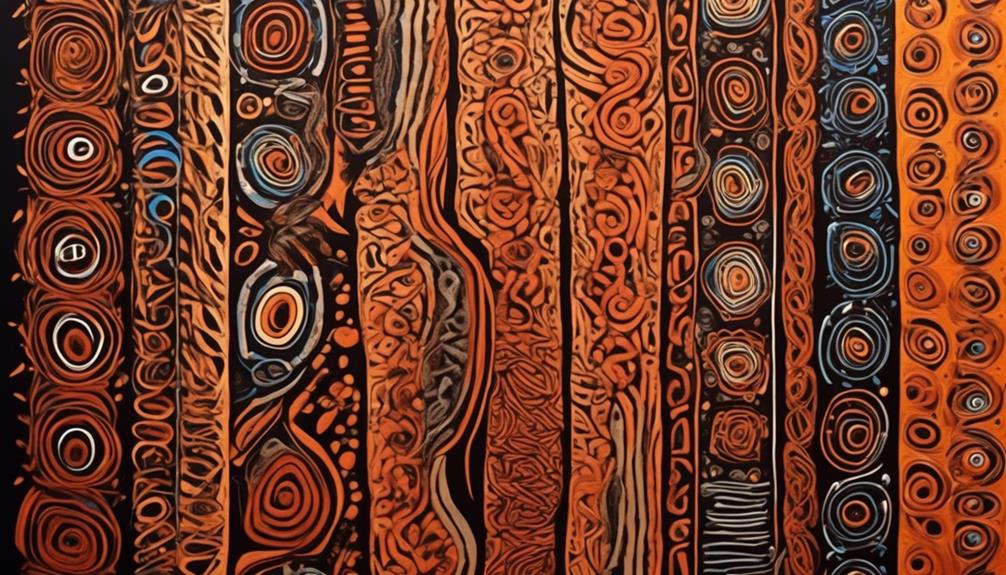
The intricate bark paintings and carvings of Indigenous Australian communities depict a rich tapestry of cultural stories and traditions, serving as visual representations of their deep connection to the land and their ancestral heritage. Bark paintings, created using natural ochre pigments on bark taken from trees such as the Stringybark, depict Dreamtime stories, creation myths, and the relationship between the people and the land. These paintings are not just decorative; they hold spiritual and ceremonial significance, often featuring intricate cross-hatching and detailed patterns that symbolize the interconnectedness of all things.
| Artifacts | Description | Cultural Significance |
|---|---|---|
| Bark Paintings | Created using natural ochre pigments on bark, depict Dreamtime stories, creation myths, and the relationship between the people and the land. | Hold spiritual and ceremonial significance, symbolizing the interconnectedness of all things. |
| Indigenous Carvings | Carved from wood, ivory, or pearl shell, represent ancestral beings, animals, and totems, embodying cultural knowledge and traditions. | Used in storytelling, rituals, and ceremonies, passing down knowledge through generations. |
Indigenous carvings, whether carved from wood, ivory, or pearl shell, represent ancestral beings, animals, and totems, embodying cultural knowledge and traditions. These carvings are used in storytelling, rituals, and ceremonies, serving as a way to pass down knowledge through generations and to maintain a deep connection to their heritage. The intricate details and symbolism in both bark paintings and carvings provide a glimpse into the rich cultural tapestry of Indigenous Australian communities.
Dreamtime Stories in Art

Dreamtime stories in Australian art hold a profound cultural significance, often serving as a visual representation of the rich symbolic traditions of Indigenous communities. The symbolism within Dreamtime art is deeply rooted in the spiritual beliefs and oral traditions passed down through generations, offering a unique insight into the cultural and historical narratives of the Aboriginal peoples.
Symbolism in Dreamtime Art
Incorporating intricate symbols, Dreamtime art encapsulates the rich mythology and spiritual beliefs of indigenous Australian cultures. The symbolism in Dreamtime art serves as a visual language, conveying profound meanings and connecting the physical and spiritual worlds.
- Spiritual Connection: The symbols in Dreamtime art often represent a connection to the land, ancestors, and the Dreamtime itself, reflecting the deep spiritual beliefs of Aboriginal cultures.
- Narrative Representation: Each symbol in Dreamtime art carries specific meanings and is often used to depict Dreamtime stories, serving as a visual representation of the complex and intricate narratives passed down through generations.
- Cultural Significance: The use of symbols in Dreamtime art is a way of preserving and sharing cultural knowledge, ensuring that the stories and beliefs of indigenous Australian cultures are perpetuated and honored.
Cultural Significance in Art
Exploring the cultural significance of art in indigenous Australian communities, the rich tapestry of Dreamtime stories is intricately woven into the fabric of their artistic expression. Dreamtime stories are at the heart of aboriginal traditions, representing the creation of the world and providing a spiritual connection to the land.
Through art, these stories aren't only preserved but also passed down through generations, maintaining a vital link to the past. Artistic symbolism in these works often reflects the deep understanding of nature, spirituality, and ancestry. Each symbol holds layers of meaning, conveying intricate narratives that are central to the identity and cultural heritage of indigenous Australians.
The use of vibrant colors, intricate patterns, and symbols in Dreamtime art serves as a visual language, encapsulating the wisdom and traditions of the past.
Ceremonial Objects and Artefacts

Ceremonial objects and artefacts play a crucial role in the cultural and spiritual practices of Indigenous Australian communities, reflecting their deep historical significance and traditional beliefs. These items are imbued with profound meaning and are utilized in various ceremonies, rituals, and spiritual practices that have been passed down through generations.
- Symbolism and Meaning: Ceremonial objects are rich in symbolism and meaning, representing the interconnectedness of the spiritual, natural, and human worlds. For instance, the use of specific materials, colors, and patterns in ceremonial objects often signifies connections to ancestral spirits, the land, and the Dreaming.
- Cultural Continuity: These artefacts serve as tangible links to the past, reinforcing cultural continuity and identity within Indigenous communities. They aren't merely historical artifacts but living objects that continue to hold deep spiritual and cultural significance in contemporary ceremonial practices.
- Guardianship and Responsibility: Within Indigenous communities, the custodianship of ceremonial objects is a sacred duty, often entrusted to specific individuals or groups. This responsibility involves preserving, protecting, and respectfully using these objects in accordance with traditional cultural protocols, ensuring their ongoing relevance and integrity.
Ceremonial objects and artefacts aren't just static representations of the past; they're vibrant components of living cultures, embodying the spiritual, historical, and cultural complexities of Indigenous Australian communities. Understanding their significance provides insight into the resilience and richness of Indigenous cultural traditions.
Stone Tool Technology
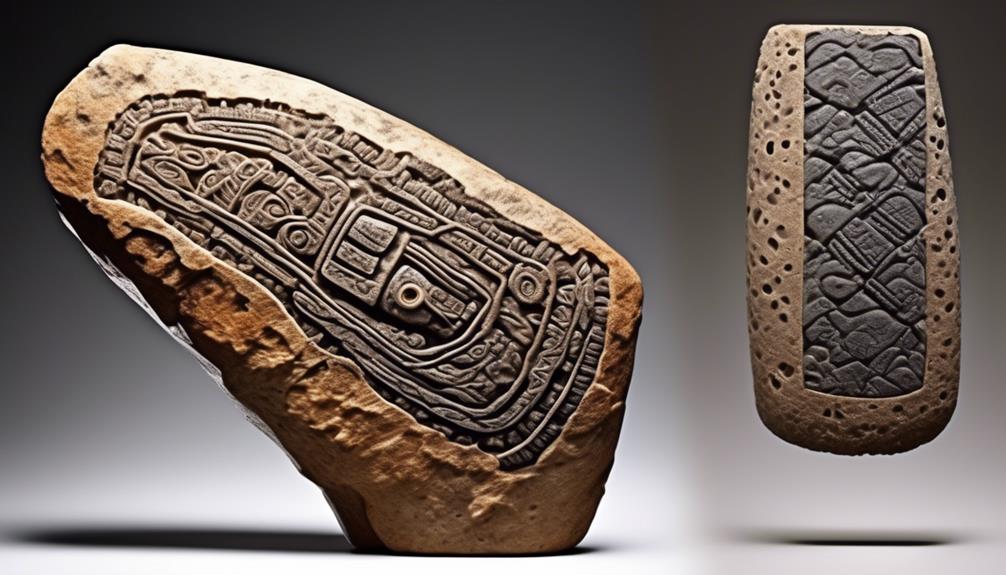
When examining the stone tool technology of ancient Australia, we can observe a remarkable diversity in the materials used, ranging from chert and quartz to obsidian and silcrete. These materials were skillfully crafted using a variety of techniques, such as flaking, grinding, and heat-treatment, showcasing the advanced knowledge and ingenuity of the early inhabitants.
Understanding the intricacies of these tool-making methods provides valuable insights into the technological and cultural advancements of the past.
Tool Material Diversity
Throughout the history of Australia, stone tool technology has played a pivotal role in the development and adaptation of early human cultures.
Material innovation: The diverse geological landscape of Australia facilitated the creation of tools from a wide range of materials such as chert, quartz, and silcrete, each with unique properties that influenced tool functionality.
Tool functionality: Indigenous Australians utilized these varied materials to create tools for specific purposes, including hunting, woodworking, and food preparation, showcasing a deep understanding of material properties and their applications.
Cultural significance: The use of diverse tool materials also reflects the cultural and environmental adaptability of early human populations in Australia, highlighting their ability to innovate and thrive in different landscapes.
The material diversity in stone tool technology not only showcases technological advancements but also emphasizes the resourcefulness and ingenuity of ancient Australian cultures.
Tool-Making Techniques
One of the key aspects of stone tool technology in early Australian cultures is the intricate and precise techniques employed in the creation of these essential implements. The tool-making evolution showcases the ingenuity and adaptability of indigenous techniques. Each tool is a testament to the ancient craftsmanship and holds deep cultural significance.
The evolution of tool-making techniques reflects the development of early human societies, demonstrating the resourcefulness and intelligence of our ancestors. Through the study of these techniques, we gain valuable insights into the capabilities and skills of ancient communities.
The methods employed in creating these tools provide a window into the technological advancements of early Australian cultures, shedding light on their way of life and the challenges they faced. Understanding these techniques offers a profound appreciation for the rich and diverse history of tool-making in Australia.
Didgeridoos and Music Instruments
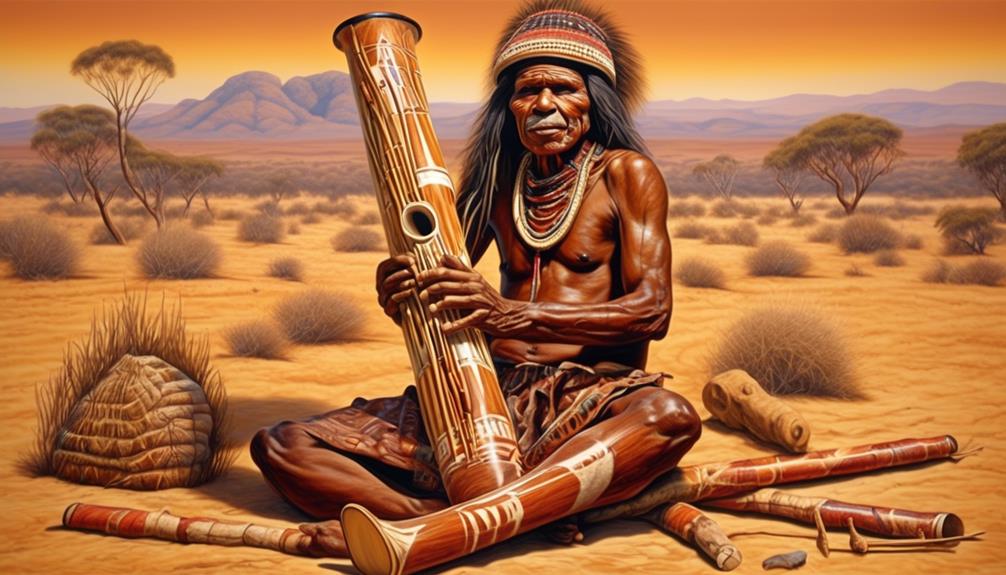
What role do didgeridoos and other traditional music instruments play in the cultural and historical context of Australia?
Didgeridoos hold immense cultural significance for Indigenous Australians, serving as both musical instruments and tools for storytelling and ceremonial purposes. These instruments have been an integral part of Aboriginal culture for thousands of years, carrying significant spiritual and historical importance. Additionally, other traditional music instruments such as clapsticks and bullroarers also play a vital role in cultural practices, rituals, and storytelling within Indigenous communities.
To delve further into the topic, it's crucial to understand the significance of these instruments in the following ways:
- Cultural Significance: Didgeridoos and other traditional music instruments are deeply embedded in the cultural identity of Indigenous Australians. They're used in ceremonies, rituals, and celebrations, serving as a means of passing down traditions and stories from one generation to the next. The unique sounds produced by these instruments are closely tied to the spiritual beliefs and practices of Aboriginal communities, making them essential elements of cultural preservation and expression.
- Conservation Efforts: Efforts to conserve and protect traditional music instruments are essential for preserving Indigenous heritage. Many organizations and initiatives focus on documenting and safeguarding the knowledge and skills associated with crafting and playing these instruments. By supporting these conservation efforts, we can help ensure the continuity of Indigenous musical traditions and the preservation of cultural heritage for future generations.
- Historical Significance: These instruments provide valuable insights into the history and traditions of Indigenous Australians. Studying the construction, use, and symbolism of didgeridoos and other traditional music instruments offers a window into the rich and diverse cultural heritage of Australia's First Nations peoples. Understanding their historical significance fosters appreciation and respect for Indigenous traditions and contributes to a more inclusive and accurate portrayal of Australian history.
Traditional Body Art and Adornments
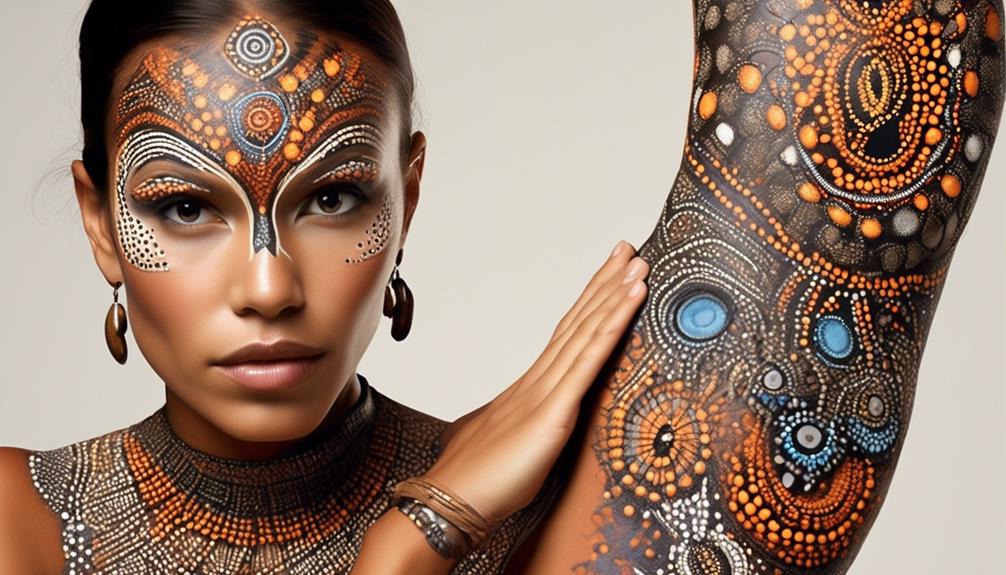
Traditional body art and adornments have played a significant role in Indigenous Australian culture for centuries.
Indigenous body paint was used as a form of expression, with intricate designs and symbols representing different aspects of the natural world and spiritual beliefs.
Symbolic body adornments, such as necklaces, bracelets, and earrings, were also used to convey social status, tribal affiliations, and important life events.
Additionally, cultural hair decorations, like feathers and shells, were worn as a way to honor traditions and connect with the land.
Indigenous Body Paint
Indigenous body paint has been a significant aspect of cultural expression and identity for various Indigenous communities in Australia throughout history. The use of body paint holds deep cultural significance, serving as a form of communication, storytelling, and connection to the land and ancestors.
Spiritual Significance: Indigenous body paint is often used in spiritual ceremonies and rituals, symbolizing the connection between the physical and spiritual realms.
Community Identity: Body paint designs vary between different Indigenous communities, with each pattern and color holding specific meanings that represent clan, tribe, or family identity.
Passing Down Traditions: The practice of applying body paint is traditionally passed down through generations, serving as a way to preserve and transmit cultural knowledge and traditions.
The use of indigenous body paint is a powerful expression of Indigenous identity and cultural resilience, embodying the rich history and traditions of Australia's First Nations peoples.
Symbolic Body Adornments
Body adornments have played a significant role in the cultural and historical expression of various communities in Australia, reflecting intricate symbolism and traditional practices. Symbolic jewelry holds deep cultural significance for Indigenous Australian communities, serving as a means of expressing identity, social status, and connection to the land. These adornments often incorporate materials such as shells, feathers, and animal bones, each carrying its own symbolic meaning. For instance, the use of kangaroo teeth in necklaces signifies strength and resilience, while emu feathers symbolize spirituality and connection to the natural world. The intricate craftsmanship and unique designs of these adornments depict stories of creation, ancestral spirits, and the ongoing connection to the land. Through these symbolic body adornments, Indigenous Australians assert their cultural identity and resilience in the face of historical adversity.
| Symbolic Jewelry | Cultural Significance | Materials Used |
|---|---|---|
| Kangaroo Teeth | Strength and resilience | Kangaroo teeth |
| Emu Feathers | Spirituality and connection | Emu feathers |
| Shell Necklaces | Ancestral stories | Shells, animal bones |
Cultural Hair Decorations
When examining the historical significance of cultural hair decorations in Australia, we're presented with a rich tapestry of tradition and symbolism that reflects the deep connection between adornments and cultural identity.
Cultural hair decorations carry immense cultural significance, often representing tribal affiliations, social status, and spiritual beliefs. The traditional techniques used in creating these adornments are passed down through generations, preserving the authenticity and artistry of indigenous cultures.
Intricately woven strands of hair, adorned with feathers, shells, and beads, not only serve as decorative elements but also as storytelling devices, conveying narratives of creation, spirituality, and connection to the land.
The intricate process of crafting these adornments fosters a sense of community and kinship, reinforcing the importance of cultural heritage and the preservation of traditional practices.
Shell Middens and Shell Art

Evidence of ancient human activity in Australia can be found in the extensive shell middens and intricate shell art that provide insights into the cultural and historical practices of the Indigenous peoples. Shell middens, which are mounds of discarded shells, hold great significance as they offer a window into the dietary habits, social structure, and environmental interactions of the past Indigenous communities. These archaeological sites not only reveal the types of shellfish consumed but also indicate seasonal patterns of occupation and the development of trade networks. The composition of the shells within these middens provides valuable information about the ancient environment and how it has changed over time.
The techniques used in creating shell art reflect the deep cultural and spiritual connections of the Indigenous peoples to the land and sea. Intricate designs carved or painted onto shells showcase the artistic abilities of these ancient communities and often depict stories, dreamtime narratives, and connections to the natural world. The use of different shell types, such as those from marine snails or oysters, also reflects the availability of resources in specific regions and demonstrates the diverse artistic traditions that existed across the continent.
Convict-era Artefacts
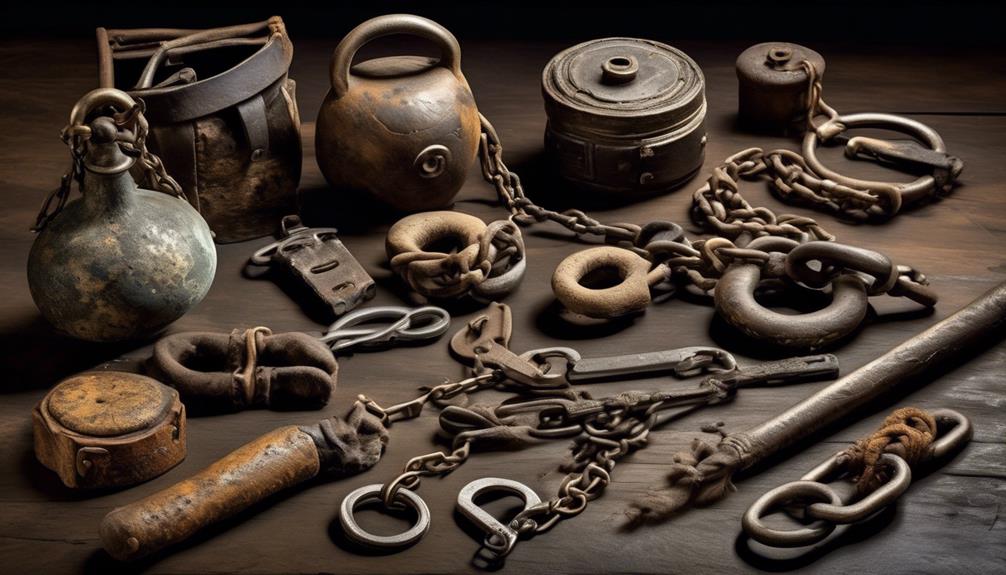
During our examination of Australia's historical artifacts, we discovered a compelling array of Convict-era artefacts that shed light on the experiences and material culture of the individuals who were part of this significant period in the country's history. These artifacts, dating back to the 18th and 19th centuries, offer a tangible connection to the lives of convicts and the early settlers, providing insight into their daily existence and the social dynamics of the time.
Convict Love Tokens: These small, intricately engraved coins or tokens, often fashioned from a smoothed-down coin, were commonly given by convicts to their loved ones before being transported to Australia. They provide a poignant glimpse into the personal lives and emotions of individuals caught in the convict system, offering a rare window into their inner world amidst the harsh conditions they faced.
Transportation Records: Preserved records from the convict era, including ship manifests, trial documents, and letters, provide invaluable insights into the origins and backgrounds of the individuals who were transported to Australia. These documents allow us to trace the age, occupation, and sometimes even the family circumstances of the convicts, shedding light on the varied paths that led them to the Australian shores.
Convict Clothing and Personal Items: Well-preserved articles of clothing, personal effects, and makeshift items used by convicts during their incarceration offer a tangible connection to the daily lives and struggles of these individuals. These artefacts provide crucial evidence of the resourcefulness and resilience of the convicts as they navigated the challenges of their new environment.
The age and origins of these convict-era artifacts provide a rich tapestry of historical understanding, offering a window into the lives of those who lived through this transformative period in Australia's past.
Contemporary Indigenous Sculpture
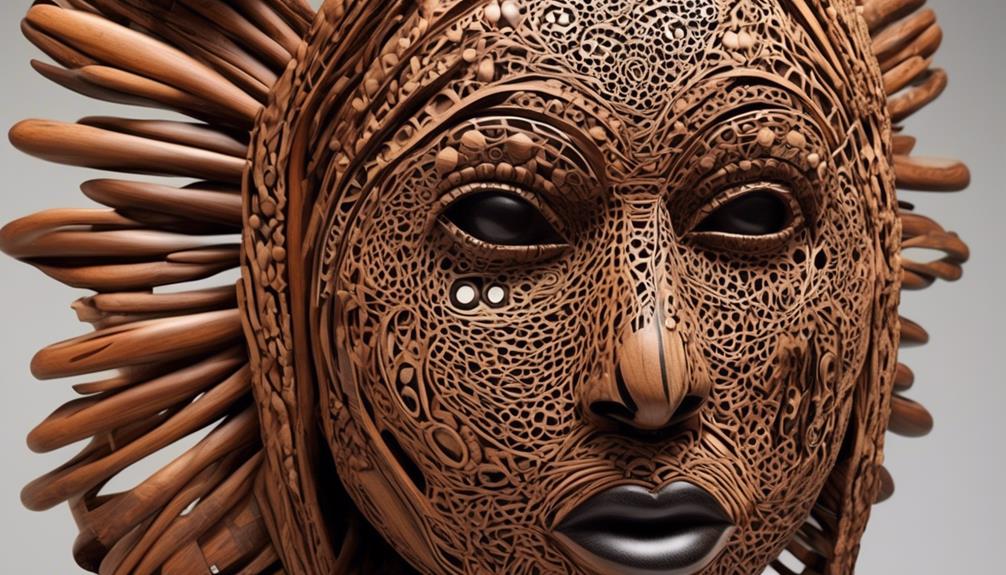
Studying the contemporary Indigenous sculpture provides a nuanced understanding of the artistic expression and cultural narratives within Australia's indigenous communities. In recent decades, Indigenous artists have adeptly merged traditional techniques with modern art forms, resulting in a profound evolution of cultural expression through sculpture. This artistic innovation hasn't only reinvigorated the visual landscape of Indigenous art but has also served as a powerful medium for asserting cultural identity and challenging historical narratives.
Contemporary Indigenous sculpture often employs a diverse range of modern art techniques, including metalwork, glassblowing, and mixed media, expanding the boundaries of traditional practices. This infusion of modern methods has enabled artists to explore new forms of expression while still remaining deeply rooted in cultural symbolism and storytelling. These sculptures aren't merely aesthetic objects but vessels of cultural knowledge, carrying narratives of ancestral connections, the land, and spiritual beliefs.
Moreover, contemporary Indigenous sculptors confront and dismantle stereotypes, offering a more authentic and multifaceted representation of Indigenous experiences. Through their work, these artists assert agency and sovereignty, contributing to a broader societal dialogue on Indigenous rights and recognition. The sculptures serve as a visual assertion of presence, resilience, and creativity, challenging the notion of Indigenous art as static or historical.
In essence, contemporary Indigenous sculpture encapsulates the ongoing cultural resilience and artistic vitality of Australia's Indigenous communities, showcasing the dynamic evolution of cultural expression while asserting a powerful narrative of continuity and innovation.
Preservation and Heritage Efforts
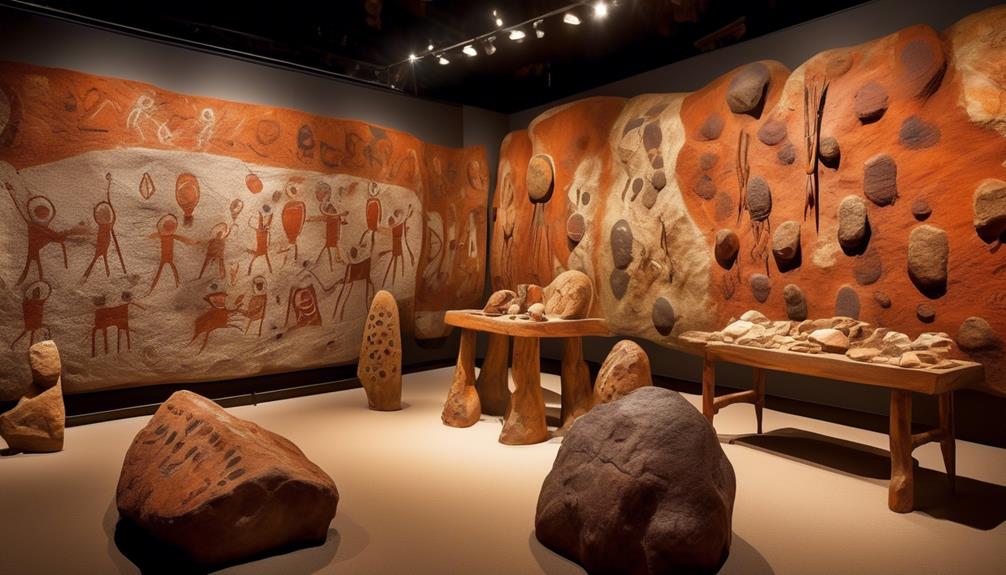
Our examination of preservation and heritage efforts reveals a complex interplay of cultural stewardship, historical significance, and contemporary challenges. As custodians of Australia's rich cultural heritage, we're tasked with implementing preservation techniques while honoring the heritage significance of the artifacts. This involves a delicate balance of conservation and accessibility, as we strive to protect these artifacts for future generations while also ensuring that they remain accessible to the public.
- Conservation Technologies: The advancement of conservation technologies has greatly enhanced our ability to preserve artifacts. From state-of-the-art climate-controlled storage facilities to advanced digital imaging techniques, these technologies play a crucial role in safeguarding Australia's cultural heritage.
- Community Engagement: Engaging local communities in the preservation of their heritage is essential. By involving indigenous communities and local stakeholders in decision-making processes, we can ensure that preservation efforts are culturally sensitive and aligned with the values of the communities to which the artifacts belong.
- Policy and Legislation: Robust policies and legislation are vital for the protection of Australia's cultural heritage. By enacting laws that regulate the export, sale, and conservation of artifacts, we can prevent the loss of culturally significant items and ensure their long-term preservation.
In navigating the complexities of preservation and heritage efforts, we remain committed to upholding the integrity of Australia's cultural heritage while adapting to the contemporary challenges that arise.
Frequently Asked Questions
What Are the Most Valuable Australia Artifacts in Terms of Monetary Value?
In terms of monetary value, the most valuable Australia artifacts are those with significant historical significance. These artifacts often fetch high prices due to their rarity and cultural importance.
Items like ancient Aboriginal tools, ceremonial objects, and early colonial artifacts hold great worth in the art market. Their value isn't just monetary but also reflects the deep historical and cultural significance of Australia's heritage.
Are There Any Ancient Aboriginal Tools That Have Been Found Outside of Australia?
Yes, ancient aboriginal tools have been found outside of Australia, and their global distribution is of great cultural and archaeological significance.
These artifacts offer insights into ancient trade routes, cultural exchanges, and human migration patterns. Their presence in various regions highlights the interconnectedness of ancient civilizations and the diversity of aboriginal tool-making techniques.
Understanding their dispersion contributes to a more comprehensive understanding of human history and the significance of aboriginal cultures.
How Have Colonial-Era Relics Been Preserved and Protected Over Time?
Preservation techniques and conservation efforts for colonial-era relics have evolved over time. Our ancestors safeguarded these artifacts through meticulous care and strategic placement, ensuring their protection.
Today, advanced technology and expertise allow for more effective preservation and restoration. Conservation efforts are vital in maintaining the historical integrity of these relics, allowing us to connect with our past and learn from it.
Are There Any Specific Regulations or Laws Governing the Ownership and Sale of Indigenous Artworks Today?
Ownership regulations, art market, cultural heritage, and indigenous artists are all essential elements to consider when discussing the specific regulations or laws governing the ownership and sale of indigenous artworks today.
These regulations play a crucial role in protecting the cultural heritage of indigenous communities and ensuring fair compensation for indigenous artists in the art market.
It's important to analyze the historical context and current implications of these regulations for a comprehensive understanding.
What Is the Process for Identifying and Authenticating Convict-Era Artifacts?
Identifying process for artifacts involves meticulous examination and comparison with historical records.
Authentication process requires scientific analysis and expertise to verify materials and construction methods. Involving experts in historical research and forensics is crucial.
Understanding the context and provenance of each artifact is essential for accurate authentication.
Preserving the integrity of these artifacts ensures the accurate representation of our historical narrative.
Conclusion
As we journey through the rich tapestry of Australia's artifacts, we uncover the layers of history and culture that have shaped this ancient land.
From the ancient Aboriginal tools to the contemporary indigenous sculpture, each artifact tells a story of resilience and creativity.
Like a mosaic of time, these relics paint a vivid picture of Australia's heritage, inviting us to explore and appreciate the depth of its cultural legacy.
